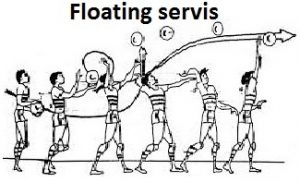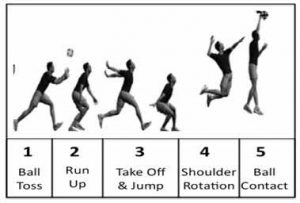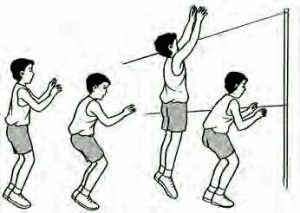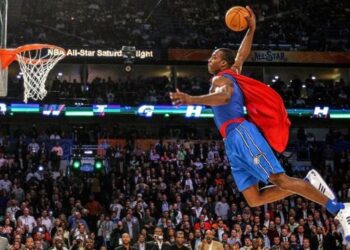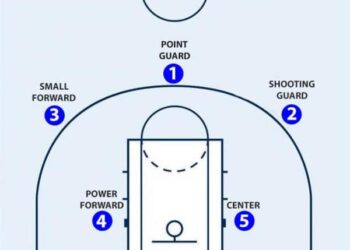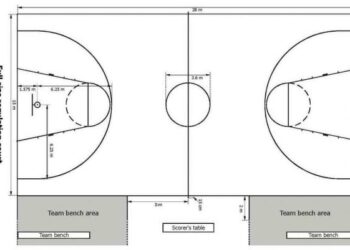Volleyball is a game created by William G. Morgan in 1895 under the name Mintonette now known as Volley Ball. Volleyball itself can be played on indoor and outdoor courts with a net for the men’s 2.43 meters and the women’s 2.24 meters.
This game is quite difficult for laypeople to play, because to learn this game we usually have to withstand the pain to do the punches and we also have to learn the techniques of the game that can not be done in a short time. Before you learn any other techniques, to become a professional we have to learn the basic techniques of volleyball.
Know the basic techniques of volleyball
The basic technique of the Volleyball Game is divided into 4, namely Block, Service, Smash or Spike, and Passing, where all these techniques must be mastered by all volleyball players. There will be more highlights in the player’s position, such as as a Libero you have to be adept at giving passes or passing to players who will do smashes. Here is an explanation of each movement.
Basic service movement techniques
The basic technique of service is the blow done from the backline area of the game field until it soars over the net and lands inside the opponent’s area. Service techniques are performed at the beginning of the game, when there are additional points and violations occur.
Service Technique has 4 kinds of service below, floating service or floating overhand, overhand round-house service, and jumping service.
Underhand Service Techniques
The bottom service technique is usually done by beginners because this technique is the easiest and most commonly used technique. The bottom service technique is done by:
- Hold the ball with your left-hand parallel to the waist.
- Slightly bent body
- Swing your right hand to hit the ball with your clenched hands.
This technique does look easy. But if practiced it will be noticeable that the difficulty in doing the service down is directing the ball as desired, with frequent exercises and routines you will easily do the service down.
Floater Serve Techniques
Floating overhand service technique is a service technique where the soaring ball does not rotate so that it appears to float or float in the air.
Floating service can be done by:
- Stand facing the field.
- Position both legs parallel to the shoulders.
- Hull the ball upwards (higher than the head).
- Hit the ball in the back center.
Overhand Around Service
Overhand round-house service has another name Hook Service. This service is quite difficult to do. To do this service you have to have the precision to hit the ball to get through the net and the ball has to rotate so as not to become a floating serve. The ways to do this are:
- Hold the ball in front of the body with your left hand.
- Throw the ball up and give the farthest deviation to the right hand and bend the left foot a little bit.
- Hit the ball with a circular swing from the right hand when the position is right and make the left foot as a weight focus.
At first glance, this service is like floating service, but the difference lies in polishing the ball. Because floating service ball movement is silent should not be until spinning, while overhand around service utilizes the turn of the ball to get a service that can swoop or turn.
Jumping Serve
Jumping service is the hardest teknk service because besides the accuracy when hitting the ball we have to have accuracy in jumping to perform service.
In addition to the hardest technique this technique is also the coolest technique to perform service because this technique is often done by professionals. The advantage of this technique is that it is more difficult for opponents to drive because of the speed of the ball which is harder than other techniques. The techniques are:
- Stand a little far from the back of the field.
- Hold the ball with both hands.
- The hull of the ball is about 3 meters from the ground.
- If you feel like you have the right moment lower your body and bend your knees to prepare to jump as high as possible.
- Hit the ball like a smash by bending the wrist to create a topspin punch.
This movement can not be mastered in a short time other than often practicing you also have to have high flying hours to complete this professional technique.
Basic Passing Techniques
The basic technique of passing movement or also can be called reception is a technique that aims to receive, hold and control the ball service from the opposing player passing technique in to two kinds namely upper passing and lower passing, Here is an explanation of each.
Basic technique of passing up
Upper Passing Technique is a technique commonly used to provide bait or set up from the toser to the player who will do the smash, therefore this top passing technique is very useful in volleyball games.
Upper passing or overhand pass is divided into 2 i.e. upper passing technique as high as face and normal upper passing. Normal top passing and upper passing as high as the face is the same, only the difference lies in the position of the ball when passing. Normal Upper Passing is where the position of the ball is above the front of the player’s face, while the forward pass is the position of the ball right in front of the player’s face. Here’s the correct way to do the top pass:
- Open the legs as wide as the shoulders and knees slightly bent.
- Both hands are in front of the forehead, both thumbs and forefinger form triangles. The view should focus on the direction the ball is coming.
- When the ball comes, take the ball with your fingers, bend your wrists inwards. When accepting try to relax hands.
- Push the ball by moving the wrist out and followed by an elbow straightening motion.
- Move your feet a little hard.
Basic Techniques of Passing Lo-Down
The lower passing technique is also an important technique for amateur players to become professionals. because this technique is usually done to receive service balls and smashes from opponents. Lower Passing is divided into 2 kinds, namely the basic technique of passing under one hand and the basic technique of passing under two hands, here is the explanation of each:
- Basic Techniques of Passing Lo-Down with One Hand
The basic technique of passing under one hand is a state where the player’s range is too far and low to make the upper pass. This usually happens when the first player receives an imperfect ball in returning the ball. This technique is performed in a slightly bent body way, but if it is felt still unable to reach the player’s range then usually the player will jump flying to save the ball.
- Basic Techniques of Passing Lo-Down with Two Hand
The basic technique of lower passing is usually performed when the ball is perceived to fall right in front of the player. This technique is usually performed when receiving service and smash from enemies who are still within range but the position of the ball is too low. The basic technique of passing under two hands has 2 kinds of methods namely The Dig and Thumb Over Palm.
The Dig technique is where the position of the hand is in a position such as spooning by clenching both hands. The Dig technique is a technique that is often used to receive the service of opponents because with this technique we can steer the ball as we wish, but this technique is more difficult than thumb over palm technique.
The Dig technique is the position of the right hand holding 4 fingers of the left hand and the thumb of the left hand piercing the thumb of the right hand or vice versa. The Dig is a technique very commonly used by volleyball players, The Dig technique is also very often taught to students by their sports teachers, this is because The Dig technique is easier to practice and The Dig is considered to have a higher degree of accuracy when performing Passing than thumb over palm technique.
Meanwhile, the thumb over the palm of the left hand clenched and the right hand holding the left hand. Keep in mind that this technique is the defining technique in the game. If in passing you are quite adept at the small possibility that the enemy can score, and vice versa if your reception is very lacking, then each enemy performs an attack most likely the ball is not very highly acceptable and can increase the enemy’s score.
Basic Blocking Techniques
The Blocking Technique is the only technique that players choose. Because blocking techniques are only used to withstand and prevent attacks from opponents such as smashes. Therefore this technique can only be done by players who have a high body, but do not close the possibility of our height increasing one day and enough to be able to perform blocking techniques, so this technique also has to be mastered.
How to perform this technique is quite difficult if you have met your opponent must understand the situation when the enemy will do a smash or attack and when the enemy will commit a hoax. Here’s how to perform blocking techniques in general:
- Get ready near the net.
- Knees bent prepare to jump, the position of the hand in front of the chest prepares to block the ball.
- At the right time jump as high as possible with your hands tight and pointing upwards. Remember your hands must be tight so that the ball does not escape redeeming your hand gap.
- Land with a slightly bouncing leg to minimize the risk of injury
Blocking technique when viewed by many people who do, then it can be divided into 2 kinds namely single Block and Block friends. Single blocking is done by one player while blocking friends is done more than 1 person, usually 2-3 people.
At the point of view of block technique movement can be divided into 2 namely active blocking technique and passive blocking technique. The active blocking technique is a situation where the player who blocks moves the hand firmly so that the position of the hand becomes very close to the net. The passive blocking technique is the moment when the player who blocks does not move hands while doing blocks.
If at the time of practice, blocking techniques usually done with yourself alone is enough, without a real smash.
Basic Smash or Spike Techniques
Smash or spike technique is jumping and hitting volleyball with the smallest degree of tilt and greatest force towards the opponent’s area. The Smash technique is the most interesting technique to learn from the basic technique of volleyball, because it is the coolest technique and becomes a scourge for the opposing team because the right basic smash technique can increase scoring.
Smash technique is not easy to learn and master, because we have to have an instinct where and when we have to hit the ball to get the right shot. Not only that, when we get into the game we also have to be able to get past the blocking from the opponent.
In general, how to do Smash are:
Prefix: Take a distance of about 3 meters from where the ball will soar. Take a slightly wide step with one foot followed by the other next to it. It is handled with hand gestures extended forward swung backward.
- Jump: Jump as high as you can. When jumping makes sure your hands swing upwards and prepare to smash.
- Punch: Hit the ball into the opponent’s area with a little polish so that the ball can spin and go down swooping.
- Landing: Land with a slight bounce to reduce the risk of injury or sprain.
Smash according to the direction of the ball divided into 2 i.e. cross smash and straight smash. As the name suggests, a cross smash is a smash directed diagonally to the left or to the right to target an opponent’s empty area. While the technique of smash straight is a smash that leads straight forward because it feels like a punch and space in front is suitable to be targeted.
Smash according to the set-up or bait is divided into 4 kinds namely open smash, semi smash, quick smash, push smash.
- Open Smash: Open Smash is performed when the batsman performs the initial movement after the feeder releases the bait ball. The ball is hit while at the top of the jump and the highest range of the arm.
- Semi Smash: Hitters walk slowly towards the fall of the ball at a slow pace. When the ball is at a height of approximately 1 meter above the net, then the player must immediately take a jump and hit the ball
- Quick Smash: Once the ball reaches the feeder then the hitter must immediately take the smash step. When it’s about one arm’s length with the ball, the batsman takes a jump with his hands ready to hit. The feeder delivers the ball right in front of the bat, hit it immediately.
- Push: Smash Hitter before doing a smash run off the field standing near the net post. The batsman moves the prefix in parallel direction on the net when the height of the ball is felt when the batsman has to jump up and hit the ball immediately.
Smash technique according to the curve of the ball is divided into 3 namely Drive Smash, Top Spin, and Lob:
- Drive Smash is a ball punch that directs the ball with a long curve and leads out of the net. This smash is done with the palm forming a spoon, the hand-cut is rotated counterclockwise, the target of the blow on the ball in the back towards the front.
- Top Spin Smash is a ball punch performed to get a spin that swoops sharply into the opponent’s area. In this movement, the most important thing is to the flexible movement of the wrist and the hardness of the punch.
- Lob Smash is a smashing punch that focuses on the spin of the ball rather than the speed of the ball. Lob Smash is done by polishing the ball until it spins so that the ball does not fall off the line. Lob balls are commonly used when the game in the team area is dead and forced to give the ball to the opponent.
- Smash technique according to the Prefix is divided into 4 kinds of smash without prefix, with a prefix, with 1 foot, and with 2 feet.
- A no-start smash is a time when the batsman has been near the net since the start and is preparing for a jump. So this technique is commonly used as a braking tactic if done together, so the enemy is confused as to who will do the smash.
- Smash with a prefix is a smash in general. This technique is very often used because with the prefix we can get powerful powers.
- Smash with 1 foot is the position of the player when making the jump is one foot in front and one foot behind or not aligned so that the jump of the hitter is pushed forward.
- Smash with 2 feet is the position of the hitter when going to make the jump with two legs parallel as usual.
Being an amateur player who goes to professional needs training and hard work so that we can have skills recognized by the community. But it all starts with a basic technique, just a deeper study. Do not get bored quickly in undergoing this basic volleyball technique practice, because with a good base we can make good advanced techniques as well, professional players still do basic exercises even though they are very proficient.



